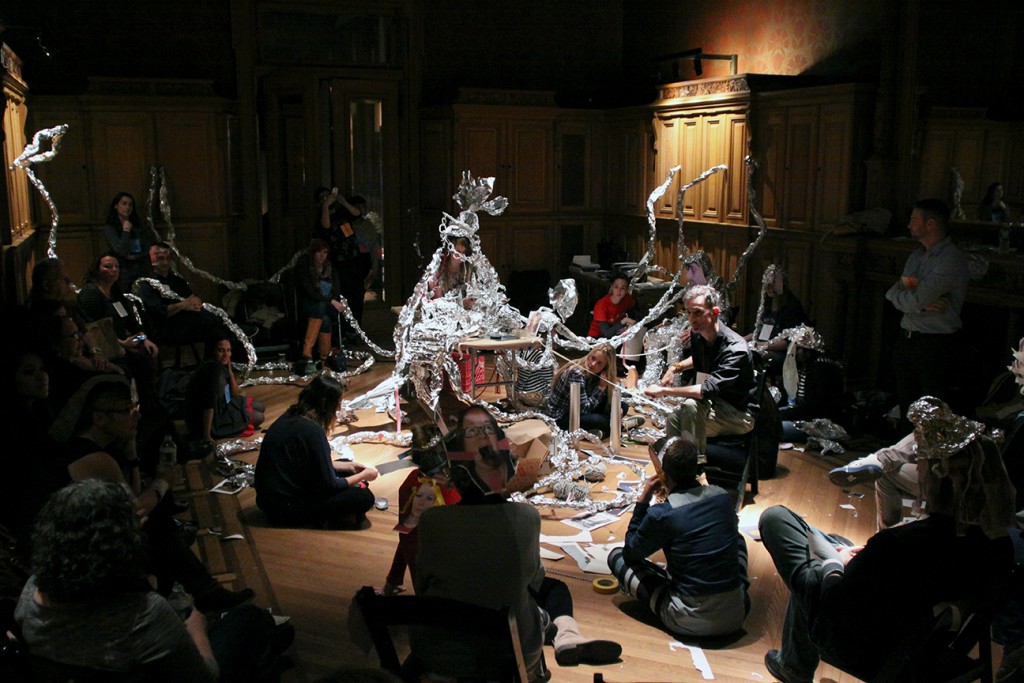
“Areas for Action,” an experiment facilitated by artist Oliver Herring and ART21 Educator Jethro Gillespie at “Creative Chemistries,” Park Avenue Armory, New York, 2015.
Creative Chemistries: Radical Practices for Art + Education was not a conference, symposium, nor a lecture. Defying common meeting formats, Creative Chemistries was a platform for exchange and an experiment in building more equitable and productive relationships among artists, teachers, policymakers, museum educators, and students. Premised on the creative potential of connecting people across institutional and disciplinary perspectives, our goal was to bridge fields of practice and generate alliances between practitioners who rarely sit across from each other at the same table. How might the creative exchanges between an artist and a classroom teacher, a principal and a policy maker, inspire visionary educational practices, reframe artists’ work, and further the promise of these individual fields?
Over the course of two days, 175 classroom teachers, museum educators, artists, community-based artist/educators, policymakers, school administrators, and students from fifteen states came together at the Park Avenue Armory in New York City. Creative Chemistries experimented with conversational formats and hands-on experiences that allowed participants to discuss, debate, and play with new ideas and new practices. Four themes: Twenty-First-Century Citizens; The Intersections of Artistic and Educational Practices; Classroom as Community and Community as Classroom; and Towards Equity, Access, and Social Justice served as points of entry and a means of cultivating generative chemistries among diverse stakeholders.
To begin, Creative Chemistries presented a collection of excerpts from ART21-produced films that introduced participating artists and reflected a range of perspectives on artistic methods, the functions of art, ways that artists have adapted pedagogical strategies, and how artists consider their audiences and the impact of their work. Following the films, three panelists—Sandra Jackson-Dumont, Frederick P. and Sandra P. Rose Chairman of Education at The Metropolitan Museum of Art; Rebecca Belleville, ART21 Educator and Baltimore teacher; and artist Luis Camnitzer—shared personal stories from their early years as students and their current practices as cultural workers.
“I think working at the intersection of art and education is a social justice act.”
—Sandra Jackson-Dumont, The Metropolitan Museum of Art Sandra Jackson-Dumont opened the conversation by suggesting a new paradigm for art education: “I think working at the intersection of art and education is a social justice act. I think it’s an equity issue because it’s about the freedom to think critically about the world you live in, but also to have the tools that allow you to navigate the world for yourself.” Rebecca Belleville added, “The reason I’m still committed to art education, and why I’m still committed specifically to urban art education, is the need for critical thinking.” Later in the conversation Luis Camnitzer pushed further: “A good education would fight existing structures to challenge the canon… A good education program or a museum should ask how can we create as many heretics as possible so that the canon can be shifted, can be adapted, and be owned by the people who should own it.”
Using these critical aspirations for art and education as a foundation, Creative Chemistries explored additional issues that define the field today:
- the role of the educator and artist in the face of privilege, power, and social injustice
- process-driven teaching, learning and un-learning that inspires critical thinkers and creative problem solvers
- new opportunities to consider place-based learning and civic engagement in and beyond the walls of classrooms and school buildings
- defining, sustaining, and activating effective communities of practice
Rather than a means to a specific end, Creative Chemistries served as a starting point for continued exchange generating new norms for contemporary art education and continued engagement with these issues and new ones as they arise.
Through future Creative Chemistries gatherings, discussion on social media platforms, and extended conversations with colleagues and communities, we hope to impact education policy, broaden public understanding of artists’ work, and involve an ever-growing community of stakeholders in the enactment of radical practices in education.
Further Reading
Creative Chemistries by Jessica Hamlin and Joe Fusaro (February 5, 2015)
Revamping Art Education for the 21st Century by Jessica Hamlin and Joe Fusaro (December 9, 2014)
The Revolution: On K–12 Education by Jessica Hamlin (October 21, 2013)